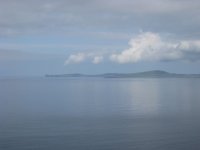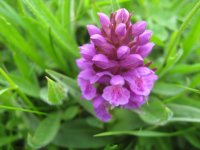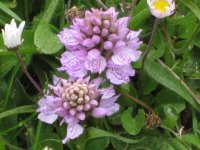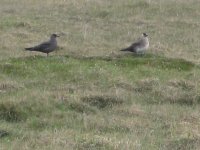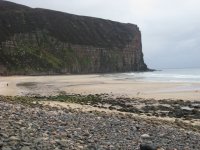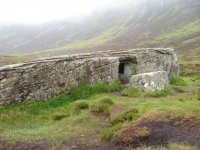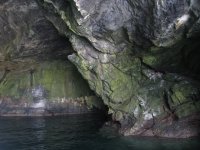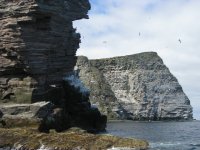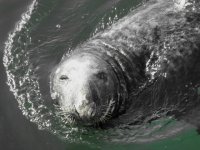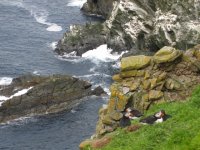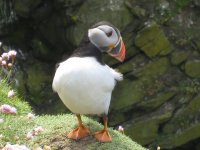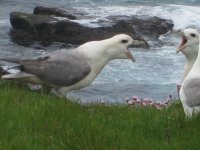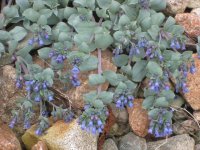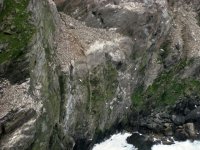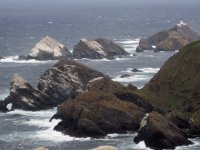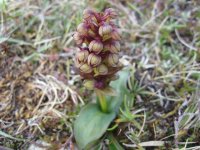brianfm
Botanical Birder
I set off early on 5th June for Kirkwall, Orkney, on what was a very hot day, and the last very hot day I was to experience over the next two weeks. It was a good job I had packed for all weathers, as that was what was to come! The first birds of interest were seen off the ferry from Aberdeen and included Fulmar, Gannet, Eider Ducks, Kittiwake, Guillemots and Black Guillemots, the first of many on the trip. After what was not the nicest of meals I decided to brave the wind on deck for about twenty minutes and I’m thankful that I did. I think I am one of very few people on board who saw the breaching Minke Whale astern of the ferry. This was a lifer for me and a good start to the trip. It breached on four occasions before disappearing leaving most, oblivious to its appearance. I arrived in Kirkwall at 11.30pm and on reaching my hotel at midnight was shown to my room by a guy from Hartlepool. I was in the rather posh new wing which had opened only the week before and still had a smell of paint, or newness as the porter suggested! I found later that if I contorted myself into strange positions I could have a view of the St Magnus Cathedral and a small bit of harbour. I was too tired tonight to contort my self into any position but a horizontal one on the king sized bed.
6th June. Now, the time on Orkney was to be devoted to archaeological exploration as much as nature and I had become a little concerned that I might tire of piles of stones. I needn’t have worried because as the week went on it became more and more of interest and time from the Neolithic period until the Second World War and beyond all began to fall into place with the help, knowledge and enthusiasm of a very good leader.
On the road out of Kirkwall we were soon watch two Short Eared Owls quartering the area and one of them at very close range as it flew in front of the vehicle. I have to say that my one and only complaint this week was the fact that the vehicle was hopeless for watching wildlife from. You would think that agencies charging high prices for tours would offer something better. I travelled with AIGAS. It’s no good the leaders having great views in the front whilst the paying customer can’t see! (We did have two leaders for six people) That’s my groan out of the way. Everywhere you looked held Oystercatchers and Curlew. We were put onto a Bearded Seal by one of the locals and we did have a long distance view of it. Sadly we had no opportunity to view this closely because we had to keep to a time at our first archaeological visit. The plan was to look later as no one could confidently say that they had identified the seal. It was certainly a rarity for the area and it would be a lifer for me so I left hoping we would get back.
Archaeological sites visited today included the 5,000 years old Neolithic tomb of Maes Howe together with some Viking runic graffiti (those Vikings were ‘cheeky’ boys), the standing stones of Stenness and the nearby Ring of Brodgar, and later in the day the Stone-age village of Skara Brae. The later very close to the sea and at risk of erosion which would be a great pity. I was well into the archaeology by now and enjoying learning so much.
Later in the day a visit was made to Yesnaby nature reserve which held a feast of botanical interest including Spring Squill as far as the eye could see. Other botanical interest included Butterwort, Milkwort, Mountain Everlasting, Heath Spotted Orchid, Northern Marsh Orchid, Wild Thyme, Lousewort and masses of Marsh Marigold which was to be with us throughout the trip. Sadly there was no Scottish Primrose in flower. It seems the timing of flowering of this plant is all to pot just now. The cliffs gave a hint of what was to come over the next two weeks and the first Arctic Skuas (both pale and dark morphs) and Great Skuas of the trip were found up close. At some point we found another Short Eared Owl taking us to three for the day and other birds seen included Fulmar, Shag, Lapwing, Ringed Plover, Redshank, Red Breasted Merganser, Common Tern, Wheatears (seen on almost every day of the trip), Hooded Crow, Raven and Reed Bunting. Also seen were Rabbit, Brown Hare, Common Seal and Orkney Vole.
Following a hearty dinner served at a speed to allow for plenty of conversation, I had a short walk in Kirkwall before heading to the horizontal position again.
7th June. We took the ferry to the island of Rousay which is approximately five miles x five miles. Another Short Eared Owl was seen before we left the mainland by ferry. The Westness Walk on Rousay contains some fine ancient monuments, the most famous being Midhowe Cairn or as it is also known ‘the great ship of death’. This is a 100ft long Neolithic burial chamber. Nearby sites include Midhowe broch, a Viking hall and cemetery, a late medieval hall and ruined 18th century farmsteads with an example of a corn drying kiln. We had all of this to ourselves. The steep walk down to the shore line had been comparatively easy, but after a pleasant lunch the climb back was exhausting.
It had been wet early on, but the rest of the day was dry making for a pleasant exploration of the island and its more recent history. Birds seen today included Common Tern, Arctic Tern, Fulmar, Mute Swan, Whooper Swan, Greylag Geese, Shelduck, Snipe, Kittiwake, Guillemot, Black Guillemot, Razorbill, Sedge Warbler, Wren and Linnet. Both Common and Grey Seals were seen. The light was wonderful as we returned to the mainland by the ferry having had a look around a very interesting information centre on the island.
8th June. Today was to be spent largely around the Scapa Flow area. I have to confess despite the importance of this area during time of war I was only vaguely aware of detail until this trip. The East Mainland is joined to the southern islands by the Churchill Barriers which divide Scapa Flow from the North Sea, and we travelled along these narrow barrier roads. Such a massive area of deep water.
Much of the birdlife was as previous days, but we did add Wigeon when visiting extensive wetland areas and also saw Snipe again. Puffin and Rock Pipit was also added to the list.
I was fascinated by the history and it helped knowing that our leader was in fact related to the guy who had been involved in initially blocking Scapa Flow for protection of shipping during the Second World War. Some of the block ships are still visible. I guess most people realise that a German U Boat managed to enter the flow and torpedo the Royal Oak which sank within thirteen minutes and that the lives of over eight hundred seamen were lost. It was thought that the U-boat was on a suicide mission, but it managed to escape and gave Germany a massive propaganda boost so early in the war. Where the Royal Oak sunk is marked by a buoy. Very thought provoking, as is beautiful Italian Chapel built by Italian POWs in a Nissan, hut. I’m not especially religious, but these things do make one stop and think and these small projects have more effect on me than large churches and cathedrals. At least one of the POWs, Domenico Chiocchetti, was an artist and the work really is magnificent. Much of the material used was scrap!
The latter part of the day was very wet so we spent some time looking at tapestries made by a local Orcadian.
9th June Today we went to Birsay and the tidal island known as Brough of Birsay which has early Christian and Norse settlements. There is much moorland around the area with small lochans and on one of them we found a pair of nesting Red Throated Divers. I had been surprised that up to now we had not seen any divers at all, but this excellent sighting made up for it. The female was low on the nest to keep out of the wind. Ringed Plover and Common Sandpiper were amongst other waders found.
We later visited the Marwick Cliffs were a memorial stands to Lord Kitchener. The ship he was travelling to Russia on was sunk off these cliffs in what was rather a mystery. It was interesting to find the memorial to the ‘good’ Lord K, but no mention of anyone else who went down with him! Isn’t that typical?
These cliffs are designed to bring on the vertigo so I concentrated on the views and birds. I was becoming amazed by the numbers of Fulmar about the whole coast. I understand that they have taken over areas where other birds used to nest. Other sea birds seen were Shag, Eider Duck, Black Headed Gull, Common Gull, Herring Gull, Lesser Black Backed Gull, Great Black Backed Gull and large numbers of Kittiwake, Arctic Tern, Common Tern, along with Guillemot (including several bridled birds), Black Guillemot, Razorbill. Puffin, Great Skua and Arctic Skua. Some other birds included Raven, Rock Dove, Skylark, Meadow Pipit, Wheatear and Reed Bunting. I certainly enjoyed my time on the cliffs today.
More post cards on their way, and it gets better and better
Photos 1)Orcadian Light 2)Ring of Brodgar 3)Northern Marsh Orchid 4)Heath Spotted Orchid 5)Arctic Skua, pale and dark morph
6th June. Now, the time on Orkney was to be devoted to archaeological exploration as much as nature and I had become a little concerned that I might tire of piles of stones. I needn’t have worried because as the week went on it became more and more of interest and time from the Neolithic period until the Second World War and beyond all began to fall into place with the help, knowledge and enthusiasm of a very good leader.
On the road out of Kirkwall we were soon watch two Short Eared Owls quartering the area and one of them at very close range as it flew in front of the vehicle. I have to say that my one and only complaint this week was the fact that the vehicle was hopeless for watching wildlife from. You would think that agencies charging high prices for tours would offer something better. I travelled with AIGAS. It’s no good the leaders having great views in the front whilst the paying customer can’t see! (We did have two leaders for six people) That’s my groan out of the way. Everywhere you looked held Oystercatchers and Curlew. We were put onto a Bearded Seal by one of the locals and we did have a long distance view of it. Sadly we had no opportunity to view this closely because we had to keep to a time at our first archaeological visit. The plan was to look later as no one could confidently say that they had identified the seal. It was certainly a rarity for the area and it would be a lifer for me so I left hoping we would get back.
Archaeological sites visited today included the 5,000 years old Neolithic tomb of Maes Howe together with some Viking runic graffiti (those Vikings were ‘cheeky’ boys), the standing stones of Stenness and the nearby Ring of Brodgar, and later in the day the Stone-age village of Skara Brae. The later very close to the sea and at risk of erosion which would be a great pity. I was well into the archaeology by now and enjoying learning so much.
Later in the day a visit was made to Yesnaby nature reserve which held a feast of botanical interest including Spring Squill as far as the eye could see. Other botanical interest included Butterwort, Milkwort, Mountain Everlasting, Heath Spotted Orchid, Northern Marsh Orchid, Wild Thyme, Lousewort and masses of Marsh Marigold which was to be with us throughout the trip. Sadly there was no Scottish Primrose in flower. It seems the timing of flowering of this plant is all to pot just now. The cliffs gave a hint of what was to come over the next two weeks and the first Arctic Skuas (both pale and dark morphs) and Great Skuas of the trip were found up close. At some point we found another Short Eared Owl taking us to three for the day and other birds seen included Fulmar, Shag, Lapwing, Ringed Plover, Redshank, Red Breasted Merganser, Common Tern, Wheatears (seen on almost every day of the trip), Hooded Crow, Raven and Reed Bunting. Also seen were Rabbit, Brown Hare, Common Seal and Orkney Vole.
Following a hearty dinner served at a speed to allow for plenty of conversation, I had a short walk in Kirkwall before heading to the horizontal position again.
7th June. We took the ferry to the island of Rousay which is approximately five miles x five miles. Another Short Eared Owl was seen before we left the mainland by ferry. The Westness Walk on Rousay contains some fine ancient monuments, the most famous being Midhowe Cairn or as it is also known ‘the great ship of death’. This is a 100ft long Neolithic burial chamber. Nearby sites include Midhowe broch, a Viking hall and cemetery, a late medieval hall and ruined 18th century farmsteads with an example of a corn drying kiln. We had all of this to ourselves. The steep walk down to the shore line had been comparatively easy, but after a pleasant lunch the climb back was exhausting.
It had been wet early on, but the rest of the day was dry making for a pleasant exploration of the island and its more recent history. Birds seen today included Common Tern, Arctic Tern, Fulmar, Mute Swan, Whooper Swan, Greylag Geese, Shelduck, Snipe, Kittiwake, Guillemot, Black Guillemot, Razorbill, Sedge Warbler, Wren and Linnet. Both Common and Grey Seals were seen. The light was wonderful as we returned to the mainland by the ferry having had a look around a very interesting information centre on the island.
8th June. Today was to be spent largely around the Scapa Flow area. I have to confess despite the importance of this area during time of war I was only vaguely aware of detail until this trip. The East Mainland is joined to the southern islands by the Churchill Barriers which divide Scapa Flow from the North Sea, and we travelled along these narrow barrier roads. Such a massive area of deep water.
Much of the birdlife was as previous days, but we did add Wigeon when visiting extensive wetland areas and also saw Snipe again. Puffin and Rock Pipit was also added to the list.
I was fascinated by the history and it helped knowing that our leader was in fact related to the guy who had been involved in initially blocking Scapa Flow for protection of shipping during the Second World War. Some of the block ships are still visible. I guess most people realise that a German U Boat managed to enter the flow and torpedo the Royal Oak which sank within thirteen minutes and that the lives of over eight hundred seamen were lost. It was thought that the U-boat was on a suicide mission, but it managed to escape and gave Germany a massive propaganda boost so early in the war. Where the Royal Oak sunk is marked by a buoy. Very thought provoking, as is beautiful Italian Chapel built by Italian POWs in a Nissan, hut. I’m not especially religious, but these things do make one stop and think and these small projects have more effect on me than large churches and cathedrals. At least one of the POWs, Domenico Chiocchetti, was an artist and the work really is magnificent. Much of the material used was scrap!
The latter part of the day was very wet so we spent some time looking at tapestries made by a local Orcadian.
9th June Today we went to Birsay and the tidal island known as Brough of Birsay which has early Christian and Norse settlements. There is much moorland around the area with small lochans and on one of them we found a pair of nesting Red Throated Divers. I had been surprised that up to now we had not seen any divers at all, but this excellent sighting made up for it. The female was low on the nest to keep out of the wind. Ringed Plover and Common Sandpiper were amongst other waders found.
We later visited the Marwick Cliffs were a memorial stands to Lord Kitchener. The ship he was travelling to Russia on was sunk off these cliffs in what was rather a mystery. It was interesting to find the memorial to the ‘good’ Lord K, but no mention of anyone else who went down with him! Isn’t that typical?
These cliffs are designed to bring on the vertigo so I concentrated on the views and birds. I was becoming amazed by the numbers of Fulmar about the whole coast. I understand that they have taken over areas where other birds used to nest. Other sea birds seen were Shag, Eider Duck, Black Headed Gull, Common Gull, Herring Gull, Lesser Black Backed Gull, Great Black Backed Gull and large numbers of Kittiwake, Arctic Tern, Common Tern, along with Guillemot (including several bridled birds), Black Guillemot, Razorbill. Puffin, Great Skua and Arctic Skua. Some other birds included Raven, Rock Dove, Skylark, Meadow Pipit, Wheatear and Reed Bunting. I certainly enjoyed my time on the cliffs today.
More post cards on their way, and it gets better and better
Photos 1)Orcadian Light 2)Ring of Brodgar 3)Northern Marsh Orchid 4)Heath Spotted Orchid 5)Arctic Skua, pale and dark morph




